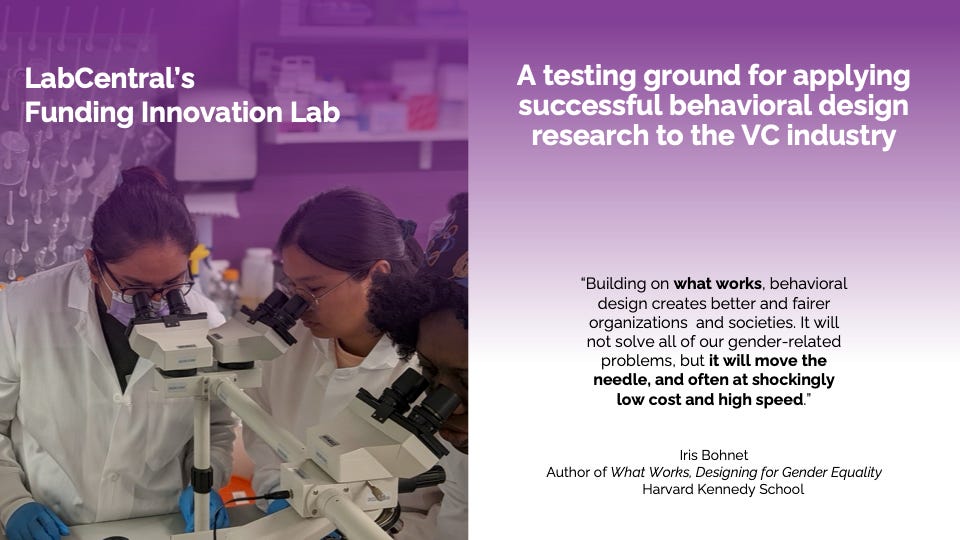Welcome to LabCentral’s Funding Innovation Lab newsletter! Each Wednesday, we’ll be sharing a quick note from Beth McKeon, as well as timely articles to spark ideas and conversations about how the Funding Innovation Lab can identify critical challenges in the biotech funding model, rapidly test potential interventions, and share results with our community.
This week, I got a notice from Cambridge, where I live, that they are automatically enrolling me in a Green energy program where 50% of my electricity is generated by solar. I don’t need to do anything at all - the new default is both potentially lower electricity bills and the knowledge that my electricity is coming from cleaner, renewable sources. This is called a Nudge.
Nudges are a social engineering concept called “Choice Architecture”, developed by Nobel-prize winner, Richard Thaler and Cass Sunstein. Nudges are basically the concept of encouraging individuals to “make better decisions by restructuring the process by which they make decisions.” (Source) It’s a way of designing for social behavior in ways that default to systems that benefit the participants.
Here’s another example of a nudge. When I started in this role at LabCentral, I was auto-enrolled in the company 401K plan with a default set to the max matched contribution. This is a well-known and well-researched nudge as well. Before this nudge was almost universally adopted by HR departments, new employees had to opt-in to their company’s 401K plan. They had to actively learn about and develop opinions about how and where to invest their 401k savings. If they didn’t, the default was no enrollment, no savings. A tiny shift in company procedure, the auto-enrollment benefited everyone.
We always have the opportunity to opt-out of the default and make other choices, but the default is designed on purpose to benefit the participants. It removes the friction of choice and of having to develop expertise in an unfamiliar subject in order to make the best decision.
Part of the philosophy of LabCentral’s Funding Innovation Lab is built on the idea of nudges. Where can our systems and rituals and activities in the funding process have baked-in nudges that benefit everyone?
In fact, we already have many “baked in” rituals and activities. These defaults just don’t serve everyone equally right now. I don’t think they were designed to exclude either. We’ve just been operating from a place of default hard when we could be operating from a default easy (or easier, at least).
We don’t yet know what all of the nudges might be that open up doors and opportunities for funding equity. We need to be discussing these concepts together, sharing observations of both the components that need to be redesigned and tested and possible pathways for solutions. You may have even seen some promising nudges in your organization or elsewhere that can be tested and amplified through the Funding Innovation Lab. I am absolutely certain we can see the kind of real change we all crave when we begin experimenting with interventions that actually shift behavior. Let’s get started.
Do you know of organizations that are trying something new to create a more equitable funding environment? Let’s round up some examples!
What is the Funding Innovation Lab?
Subscribe to the newsletter
If you are passionate about increasing funding equity for women and people of color, please be sure to subscribe to this newsletter!
We’ll be open-sourcing our work and would love to include you in the process as well. The newsletter is the best way to find out about opportunities to get involved.
What we’re reading
The Funding Innovation Lab relies on a large body of scholarship and research-backed approaches. Each week, we’ll share snippets from the books we’re reading that provide inspiration for the kinds of experiments we may run in the future.
Nudge, by Richard Thaler and Cass Sunstein (Amazon)
In this ground-breaking book, Dr. Thaler (University of Chicago Booth School of Business) and Dr. Sunstein (Harvard Law School), describe Nudge Theory or how choice architecture can be put to work to both preserve personal freedom of choice and design systems and structures that benefit the people using them. One of the most interesting components of nudge theory is that many nudges are exactly that…tiny interventions that create big outcomes.
“There are many parallels between choice architecture and more traditional forms of architecture. A crucial parallel is that there is no such thing as a “neutral” design…As good architects know, seemingly arbitrary decisions, such as where to locate the bathrooms, will have subtle influences on how the people who use the building interact…As we shall see, small and apparently insignificant details can have major impacts on people’s behavior. A good rule of thumb is to assume that everything matters.”
The Funding Innovation Lab is a non-profit program, founded by LabCentral and led by Beth McKeon, with a mission to increase funding equity for women and BIPOC founders in the life sciences.
The Funding Innovation Lab convenes and supports innovators from across VC, universities, and entrepreneurial support organizations, as they run rapid design sprints to solve the persistent systemic barriers and bias in the fundraising and capital deployment process. The Funding Innovation Lab has an open-source policy, sharing the wins and fails from these experiments here on Substack and with its community of practitioners with the goal to see widespread adoption and replication of emerging best practices in this field.








